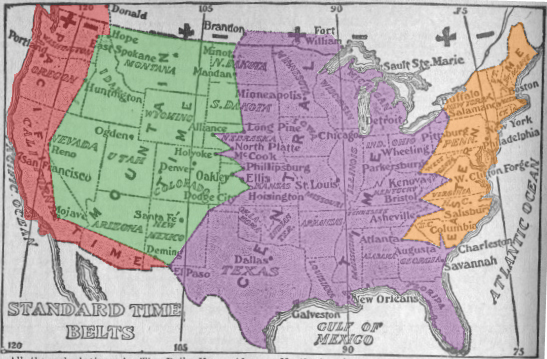Re-print from FamilyTree.com

Sick of having to change your watch when you travel? Puzzled as you make phone plans with family across the country? You’re not alone. On March 19, 1918, the US Congress passed the Standard Time Act, officially establishing the four time zones we have today and ending the “wild west” days of time management.
Let’s take a look at a brief history of time zones in the United States. The time zone map above shows the four zones as they were just a few years before their official adoption.
How Railroads Created Time Zones
Railroad companies first created time zones as a way of regulating schedules for their trains. Before the railroad boom of the 1800s, each town kept its own standard time, often based on the position of the sun.
But as transportation methods improved and travel times decreased, these inconsistencies created headaches for companies and passengers alike. How could a train leave Philadelphia at 10:25 am local time, travel for two hours, and arrive in Pittsburgh at 11:15 am local time? And was that train leaving at 10:25 Philadelphia time, or 10:25 Pittsburgh time? Safety was also a concern, as trains attempting to run on the same tracks at the same time could crash. To put it simply: Companies needed a way to literally make the trains run on time. The Great Western Railway in Great Britain came up with a solution first, implementing a standard “railway time” in its stations in 1840. By adopting one single time, the Great Western Railway could ensure its trains operated on the same time table. Conductors could also more easily coordinate which trains were running on which tracks at a given time, lowering the chances of a crash.
Time Zones Come to the US
Following from this early success, US companies began adopting their own railway times in the 1880s. They established four standard time zones for the continental United States in 1883.
However, many towns refused the changes, not wanting to sacrifice their independence for a corporate-mandated standard. Localities continued to keep their own time in addition to “railway time,” creating a dual time system that (if anything) made the issue worse.
The Standard Time Act of 1918
The federal Standard Time Act in 1918 put an end to these discrepancies. The act allowed the (now-defunct) Interstate Commerce Commission to create time zones. Though the boundaries have shifted over the decades, the four original continental US zones (Eastern, Central, Mountain and Pacific) remain. The legislation also temporarily established Daylight Savings Time in most of the United States, another temporal oddity.
The map above from 1913 shows the early versions of the four US time zones. Note how Michigan, Ohio, Indiana and many of the southern states have since transferred from Central Time to Eastern Time, presumably to be on the same time as heavily populated East Coast cities like New York and Washington, DC.
For more, check out David A. Fryxell’s in-depth history of time zones. His ebook The Best of History Matters is an excellent resource for learning more about your ancestors’ world. The book contains detailed histories of different aspects of daily life, from voting to weddings to blue jeans.
Last updated, March 2021.
No comments:
Post a Comment